ACC210 Financial Accounting Task 2 Major Assignment Semester 2 - 2017
VerifiedAdded on 2020/04/01
|13
|2915
|23
Homework Assignment
AI Summary
This document presents a comprehensive solution to ACC210 Financial Accounting Task 2, covering key accounting concepts. The assignment addresses fair value measurement, including valuation techniques for land and factories. It analyzes the revaluation of assets, providing detailed journal entries and calculations for machinery. The solution also explores the accounting treatment of internally generated intangible assets, differentiating between research and development phases, comparing internally generated versus acquired assets, and explaining the reasons for managerial reluctance to recognize such assets. Finally, the assignment includes calculations related to a defined benefit superannuation plan, determining the deficit of the fund, net defined benefit liability, and net interest. This solution serves as a valuable resource for students studying financial accounting, offering insights into complex accounting principles and their practical application.
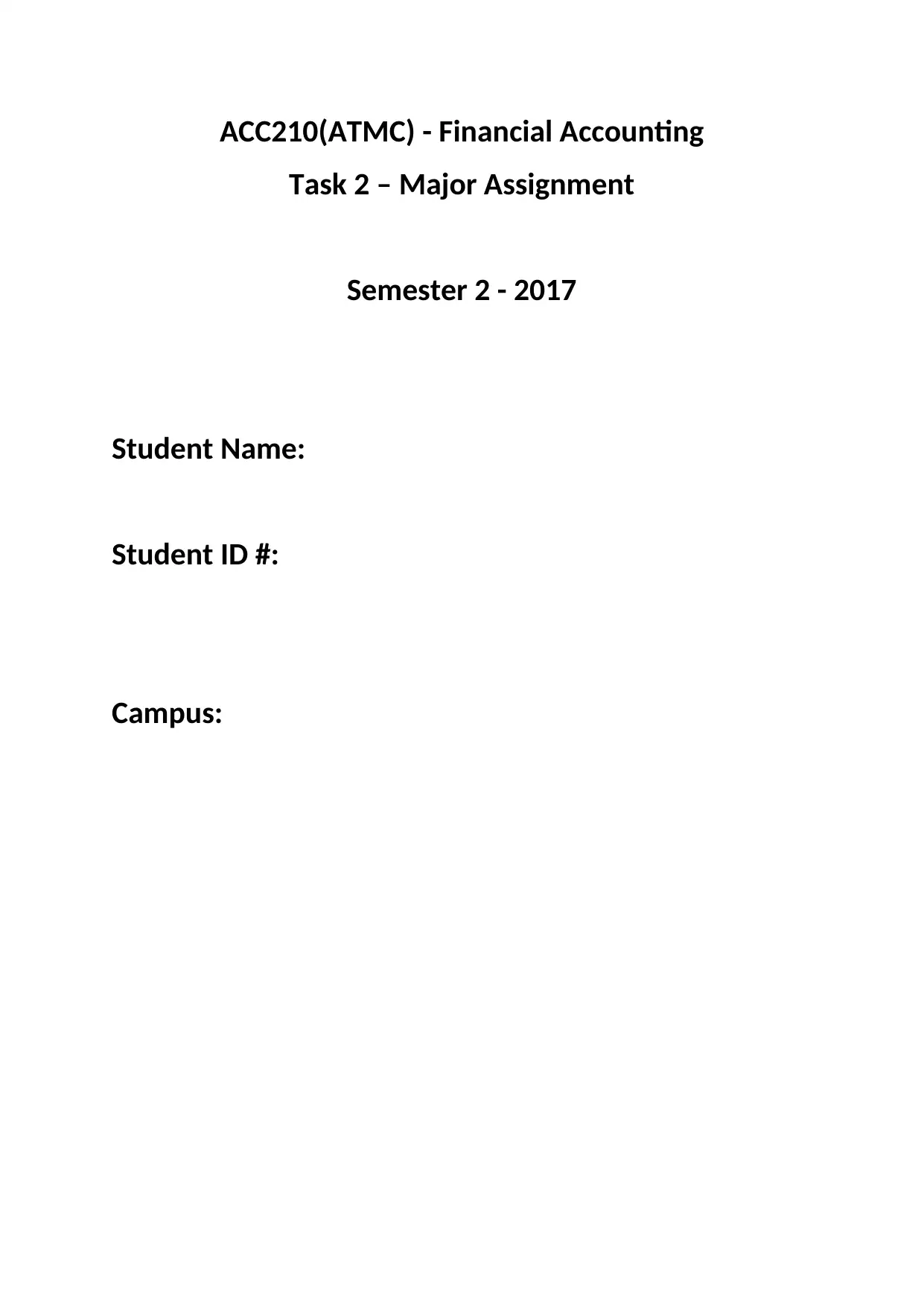
ACC210(ATMC) - Financial Accounting
Task 2 – Major Assignment
Semester 2 - 2017
Student Name:
Student ID #:
Campus:
Task 2 – Major Assignment
Semester 2 - 2017
Student Name:
Student ID #:
Campus:
Paraphrase This Document
Need a fresh take? Get an instant paraphrase of this document with our AI Paraphraser
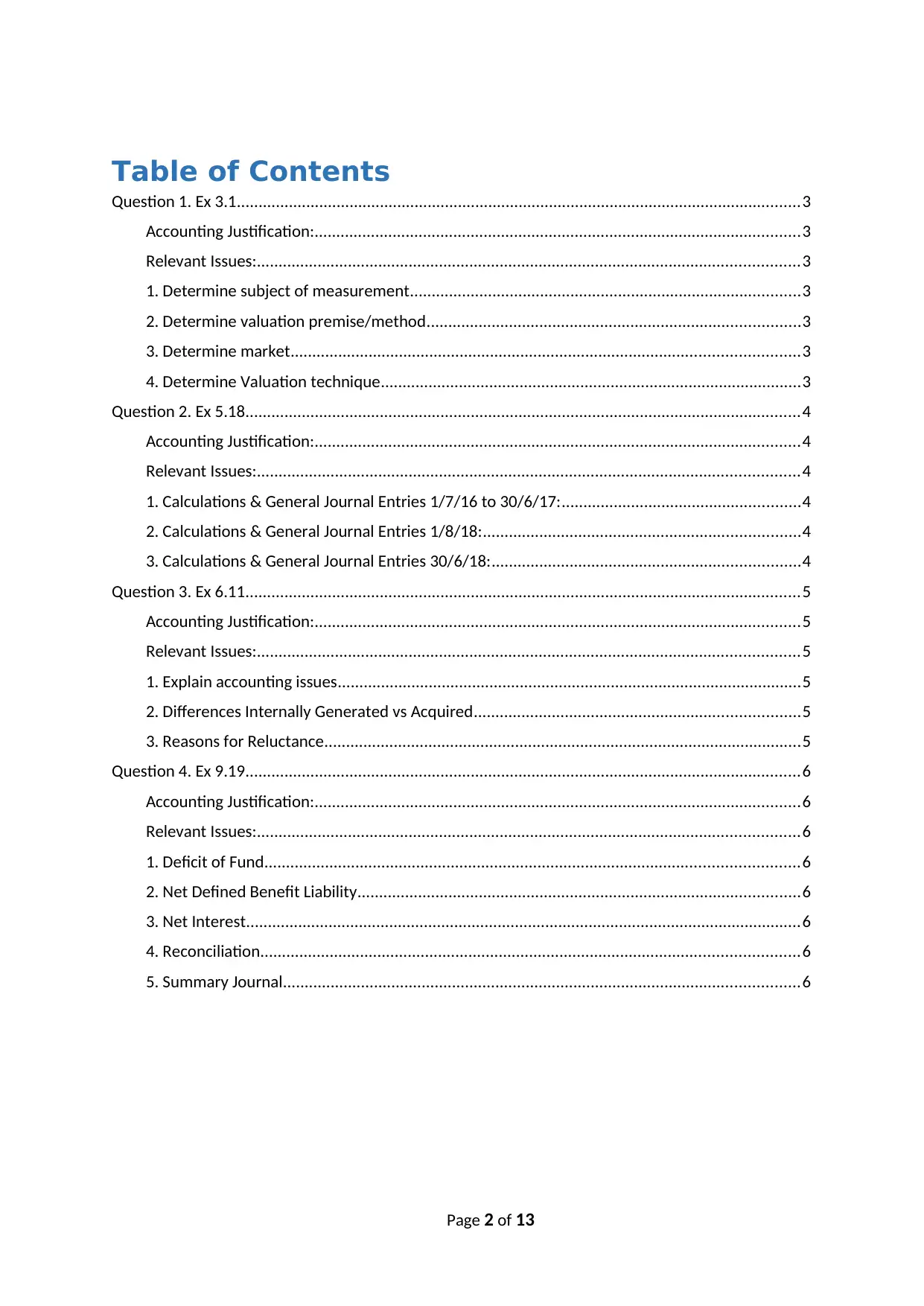
Table of Contents
Question 1. Ex 3.1..................................................................................................................................3
Accounting Justification:................................................................................................................3
Relevant Issues:.............................................................................................................................3
1. Determine subject of measurement..........................................................................................3
2. Determine valuation premise/method......................................................................................3
3. Determine market.....................................................................................................................3
4. Determine Valuation technique.................................................................................................3
Question 2. Ex 5.18................................................................................................................................4
Accounting Justification:................................................................................................................4
Relevant Issues:.............................................................................................................................4
1. Calculations & General Journal Entries 1/7/16 to 30/6/17:.......................................................4
2. Calculations & General Journal Entries 1/8/18:.........................................................................4
3. Calculations & General Journal Entries 30/6/18:.......................................................................4
Question 3. Ex 6.11................................................................................................................................5
Accounting Justification:................................................................................................................5
Relevant Issues:.............................................................................................................................5
1. Explain accounting issues...........................................................................................................5
2. Differences Internally Generated vs Acquired...........................................................................5
3. Reasons for Reluctance..............................................................................................................5
Question 4. Ex 9.19................................................................................................................................6
Accounting Justification:................................................................................................................6
Relevant Issues:.............................................................................................................................6
1. Deficit of Fund...........................................................................................................................6
2. Net Defined Benefit Liability......................................................................................................6
3. Net Interest................................................................................................................................6
4. Reconciliation............................................................................................................................6
5. Summary Journal.......................................................................................................................6
Page 2 of 13
Question 1. Ex 3.1..................................................................................................................................3
Accounting Justification:................................................................................................................3
Relevant Issues:.............................................................................................................................3
1. Determine subject of measurement..........................................................................................3
2. Determine valuation premise/method......................................................................................3
3. Determine market.....................................................................................................................3
4. Determine Valuation technique.................................................................................................3
Question 2. Ex 5.18................................................................................................................................4
Accounting Justification:................................................................................................................4
Relevant Issues:.............................................................................................................................4
1. Calculations & General Journal Entries 1/7/16 to 30/6/17:.......................................................4
2. Calculations & General Journal Entries 1/8/18:.........................................................................4
3. Calculations & General Journal Entries 30/6/18:.......................................................................4
Question 3. Ex 6.11................................................................................................................................5
Accounting Justification:................................................................................................................5
Relevant Issues:.............................................................................................................................5
1. Explain accounting issues...........................................................................................................5
2. Differences Internally Generated vs Acquired...........................................................................5
3. Reasons for Reluctance..............................................................................................................5
Question 4. Ex 9.19................................................................................................................................6
Accounting Justification:................................................................................................................6
Relevant Issues:.............................................................................................................................6
1. Deficit of Fund...........................................................................................................................6
2. Net Defined Benefit Liability......................................................................................................6
3. Net Interest................................................................................................................................6
4. Reconciliation............................................................................................................................6
5. Summary Journal.......................................................................................................................6
Page 2 of 13
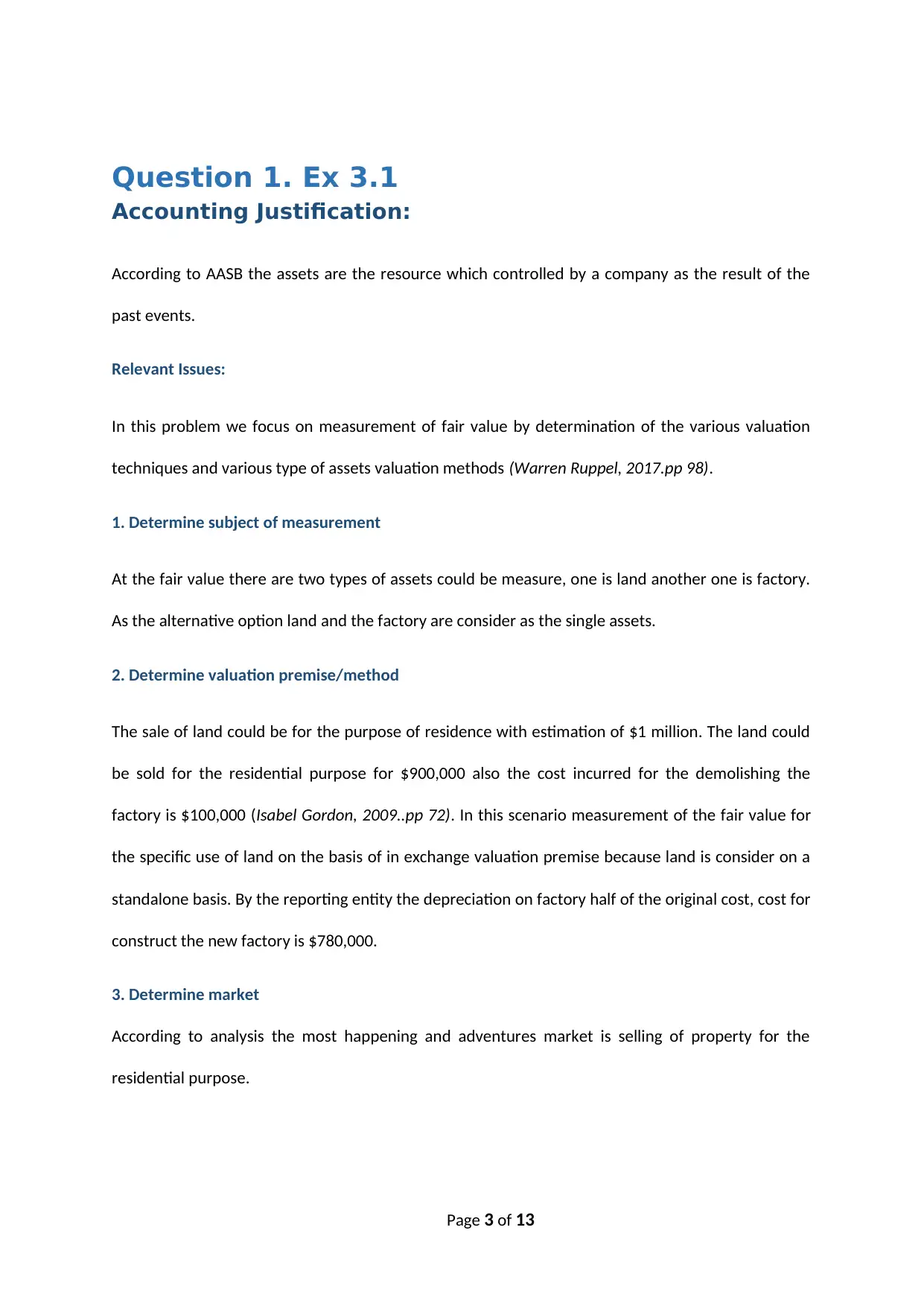
Question 1. Ex 3.1
Accounting Justification:
According to AASB the assets are the resource which controlled by a company as the result of the
past events.
Relevant Issues:
In this problem we focus on measurement of fair value by determination of the various valuation
techniques and various type of assets valuation methods (Warren Ruppel, 2017.pp 98).
1. Determine subject of measurement
At the fair value there are two types of assets could be measure, one is land another one is factory.
As the alternative option land and the factory are consider as the single assets.
2. Determine valuation premise/method
The sale of land could be for the purpose of residence with estimation of $1 million. The land could
be sold for the residential purpose for $900,000 also the cost incurred for the demolishing the
factory is $100,000 (Isabel Gordon, 2009..pp 72). In this scenario measurement of the fair value for
the specific use of land on the basis of in exchange valuation premise because land is consider on a
standalone basis. By the reporting entity the depreciation on factory half of the original cost, cost for
construct the new factory is $780,000.
3. Determine market
According to analysis the most happening and adventures market is selling of property for the
residential purpose.
Page 3 of 13
Accounting Justification:
According to AASB the assets are the resource which controlled by a company as the result of the
past events.
Relevant Issues:
In this problem we focus on measurement of fair value by determination of the various valuation
techniques and various type of assets valuation methods (Warren Ruppel, 2017.pp 98).
1. Determine subject of measurement
At the fair value there are two types of assets could be measure, one is land another one is factory.
As the alternative option land and the factory are consider as the single assets.
2. Determine valuation premise/method
The sale of land could be for the purpose of residence with estimation of $1 million. The land could
be sold for the residential purpose for $900,000 also the cost incurred for the demolishing the
factory is $100,000 (Isabel Gordon, 2009..pp 72). In this scenario measurement of the fair value for
the specific use of land on the basis of in exchange valuation premise because land is consider on a
standalone basis. By the reporting entity the depreciation on factory half of the original cost, cost for
construct the new factory is $780,000.
3. Determine market
According to analysis the most happening and adventures market is selling of property for the
residential purpose.
Page 3 of 13
⊘ This is a preview!⊘
Do you want full access?
Subscribe today to unlock all pages.

Trusted by 1+ million students worldwide
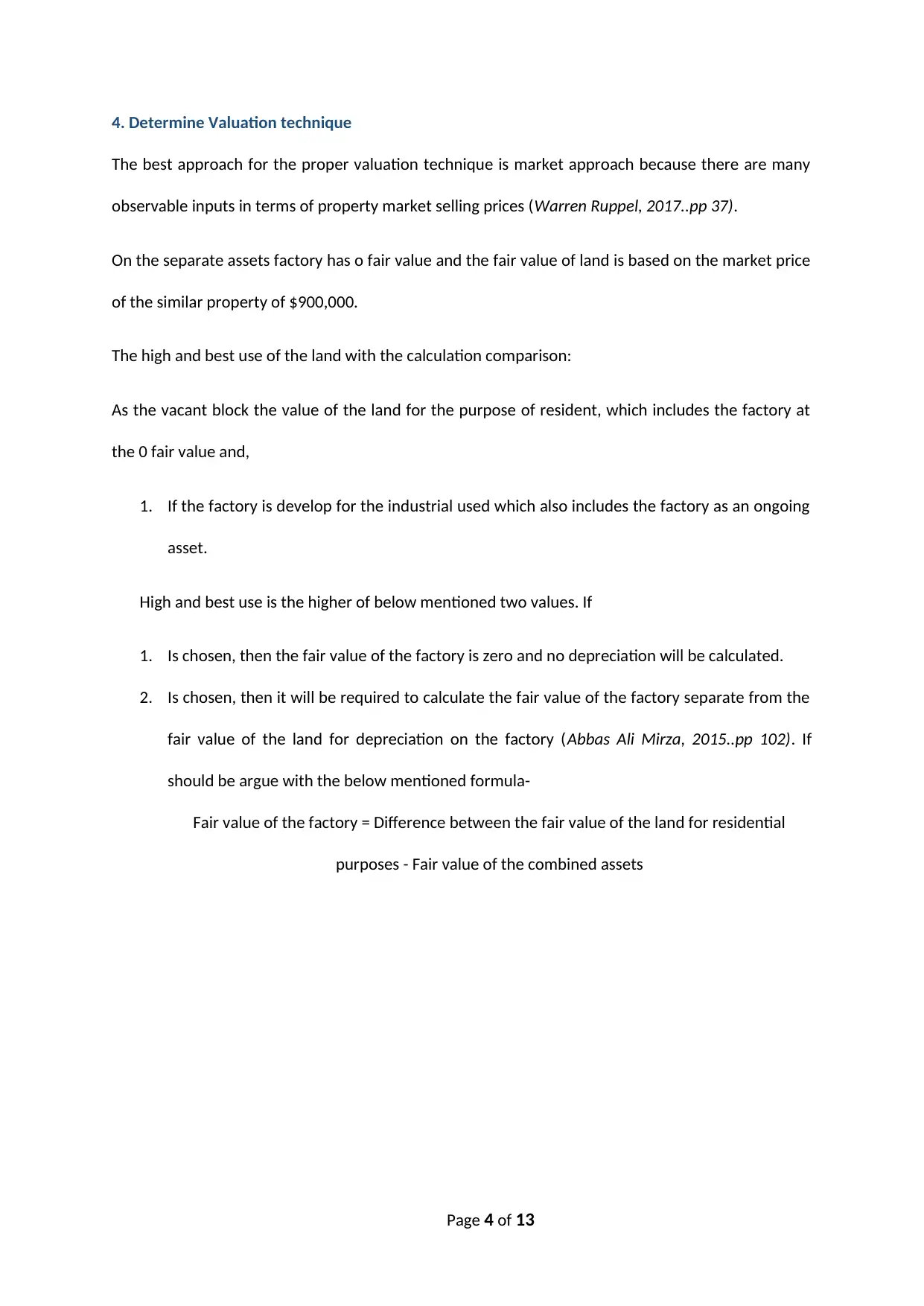
4. Determine Valuation technique
The best approach for the proper valuation technique is market approach because there are many
observable inputs in terms of property market selling prices (Warren Ruppel, 2017..pp 37).
On the separate assets factory has o fair value and the fair value of land is based on the market price
of the similar property of $900,000.
The high and best use of the land with the calculation comparison:
As the vacant block the value of the land for the purpose of resident, which includes the factory at
the 0 fair value and,
1. If the factory is develop for the industrial used which also includes the factory as an ongoing
asset.
High and best use is the higher of below mentioned two values. If
1. Is chosen, then the fair value of the factory is zero and no depreciation will be calculated.
2. Is chosen, then it will be required to calculate the fair value of the factory separate from the
fair value of the land for depreciation on the factory (Abbas Ali Mirza, 2015..pp 102). If
should be argue with the below mentioned formula-
Fair value of the factory = Difference between the fair value of the land for residential
purposes - Fair value of the combined assets
Page 4 of 13
The best approach for the proper valuation technique is market approach because there are many
observable inputs in terms of property market selling prices (Warren Ruppel, 2017..pp 37).
On the separate assets factory has o fair value and the fair value of land is based on the market price
of the similar property of $900,000.
The high and best use of the land with the calculation comparison:
As the vacant block the value of the land for the purpose of resident, which includes the factory at
the 0 fair value and,
1. If the factory is develop for the industrial used which also includes the factory as an ongoing
asset.
High and best use is the higher of below mentioned two values. If
1. Is chosen, then the fair value of the factory is zero and no depreciation will be calculated.
2. Is chosen, then it will be required to calculate the fair value of the factory separate from the
fair value of the land for depreciation on the factory (Abbas Ali Mirza, 2015..pp 102). If
should be argue with the below mentioned formula-
Fair value of the factory = Difference between the fair value of the land for residential
purposes - Fair value of the combined assets
Page 4 of 13
Paraphrase This Document
Need a fresh take? Get an instant paraphrase of this document with our AI Paraphraser

Question 2. Ex 5.18
Accounting Justification:
The revaluation gives the option to the business for carrying the fixed assets of its revalue amount.
In revaluation the amount recorded in the books are fair value of assets, less accumulated
depreciation and accumulated impairment loss (Tami Dinh, 2011..pp 98).
Relevant Issues:
In this problem we focus on the analysis of revaluation of the assets.
1. Calculations & General Journal Entries 1/7/16 to 30/6/17:
Date Account DR CR
1/7/16 Machinery A $100,000
Machinery B $60,000
Cash $160,000
30/6/17 Machine A-Depreciation expense ($100,000*1/5) $20,000
Machine A-Accumulated depreciation $20,000
30/6/17 Machine B-Depreciation expense ($60,000*1/3) $20,000
Machine B-Accumulated depreciation $20,000
30/6/17 Machine A-Accumulated depreciation $20,000
Machine A $20,000
(To record the written down value to carrying amount)
30/6/17 Machine A $4,000
Machine A -Gain on revaluation $4,000
(To record the increment of Revaluation ($84,000-
$80,000))
30/6/17 Machine A -Gain on revaluation $4,000
Machine A -Asset revaluation surplus $4,000
(To record the accumulate the net gain on revaluation in
the equity)
30/6/17 Machine B- Accumulated depreciation $20,000
Machine B $20,000
(To record the written down value to carrying amount)
30/6/17 Machine B-Loss on revaluation (Profit and Loss) $2,000
Machine B $2,000
(To record the revaluation to the fair value)
Page 5 of 13
Accounting Justification:
The revaluation gives the option to the business for carrying the fixed assets of its revalue amount.
In revaluation the amount recorded in the books are fair value of assets, less accumulated
depreciation and accumulated impairment loss (Tami Dinh, 2011..pp 98).
Relevant Issues:
In this problem we focus on the analysis of revaluation of the assets.
1. Calculations & General Journal Entries 1/7/16 to 30/6/17:
Date Account DR CR
1/7/16 Machinery A $100,000
Machinery B $60,000
Cash $160,000
30/6/17 Machine A-Depreciation expense ($100,000*1/5) $20,000
Machine A-Accumulated depreciation $20,000
30/6/17 Machine B-Depreciation expense ($60,000*1/3) $20,000
Machine B-Accumulated depreciation $20,000
30/6/17 Machine A-Accumulated depreciation $20,000
Machine A $20,000
(To record the written down value to carrying amount)
30/6/17 Machine A $4,000
Machine A -Gain on revaluation $4,000
(To record the increment of Revaluation ($84,000-
$80,000))
30/6/17 Machine A -Gain on revaluation $4,000
Machine A -Asset revaluation surplus $4,000
(To record the accumulate the net gain on revaluation in
the equity)
30/6/17 Machine B- Accumulated depreciation $20,000
Machine B $20,000
(To record the written down value to carrying amount)
30/6/17 Machine B-Loss on revaluation (Profit and Loss) $2,000
Machine B $2,000
(To record the revaluation to the fair value)
Page 5 of 13
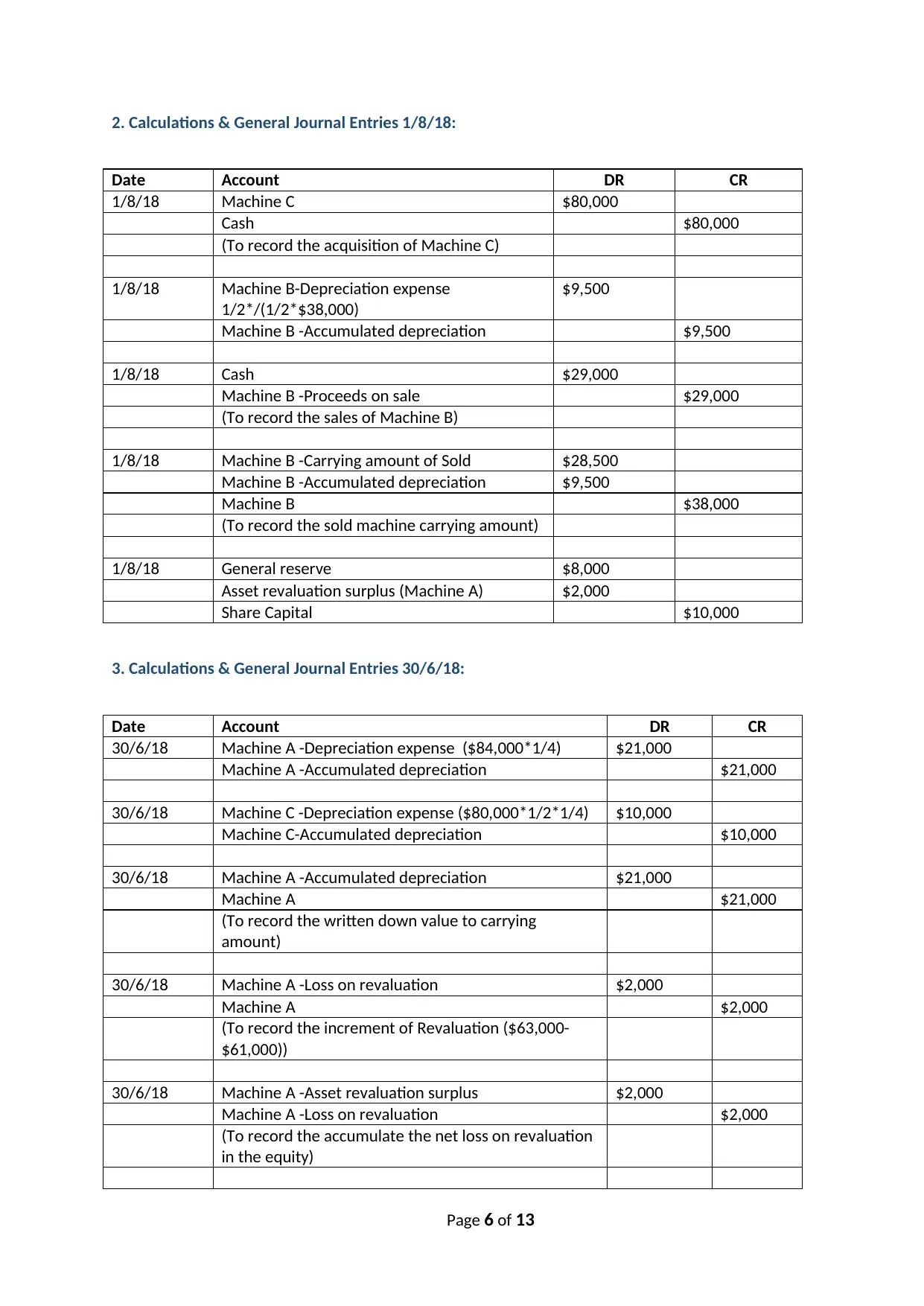
2. Calculations & General Journal Entries 1/8/18:
Date Account DR CR
1/8/18 Machine C $80,000
Cash $80,000
(To record the acquisition of Machine C)
1/8/18 Machine B-Depreciation expense
1/2*/(1/2*$38,000)
$9,500
Machine B -Accumulated depreciation $9,500
1/8/18 Cash $29,000
Machine B -Proceeds on sale $29,000
(To record the sales of Machine B)
1/8/18 Machine B -Carrying amount of Sold $28,500
Machine B -Accumulated depreciation $9,500
Machine B $38,000
(To record the sold machine carrying amount)
1/8/18 General reserve $8,000
Asset revaluation surplus (Machine A) $2,000
Share Capital $10,000
3. Calculations & General Journal Entries 30/6/18:
Date Account DR CR
30/6/18 Machine A -Depreciation expense ($84,000*1/4) $21,000
Machine A -Accumulated depreciation $21,000
30/6/18 Machine C -Depreciation expense ($80,000*1/2*1/4) $10,000
Machine C-Accumulated depreciation $10,000
30/6/18 Machine A -Accumulated depreciation $21,000
Machine A $21,000
(To record the written down value to carrying
amount)
30/6/18 Machine A -Loss on revaluation $2,000
Machine A $2,000
(To record the increment of Revaluation ($63,000-
$61,000))
30/6/18 Machine A -Asset revaluation surplus $2,000
Machine A -Loss on revaluation $2,000
(To record the accumulate the net loss on revaluation
in the equity)
Page 6 of 13
Date Account DR CR
1/8/18 Machine C $80,000
Cash $80,000
(To record the acquisition of Machine C)
1/8/18 Machine B-Depreciation expense
1/2*/(1/2*$38,000)
$9,500
Machine B -Accumulated depreciation $9,500
1/8/18 Cash $29,000
Machine B -Proceeds on sale $29,000
(To record the sales of Machine B)
1/8/18 Machine B -Carrying amount of Sold $28,500
Machine B -Accumulated depreciation $9,500
Machine B $38,000
(To record the sold machine carrying amount)
1/8/18 General reserve $8,000
Asset revaluation surplus (Machine A) $2,000
Share Capital $10,000
3. Calculations & General Journal Entries 30/6/18:
Date Account DR CR
30/6/18 Machine A -Depreciation expense ($84,000*1/4) $21,000
Machine A -Accumulated depreciation $21,000
30/6/18 Machine C -Depreciation expense ($80,000*1/2*1/4) $10,000
Machine C-Accumulated depreciation $10,000
30/6/18 Machine A -Accumulated depreciation $21,000
Machine A $21,000
(To record the written down value to carrying
amount)
30/6/18 Machine A -Loss on revaluation $2,000
Machine A $2,000
(To record the increment of Revaluation ($63,000-
$61,000))
30/6/18 Machine A -Asset revaluation surplus $2,000
Machine A -Loss on revaluation $2,000
(To record the accumulate the net loss on revaluation
in the equity)
Page 6 of 13
⊘ This is a preview!⊘
Do you want full access?
Subscribe today to unlock all pages.

Trusted by 1+ million students worldwide
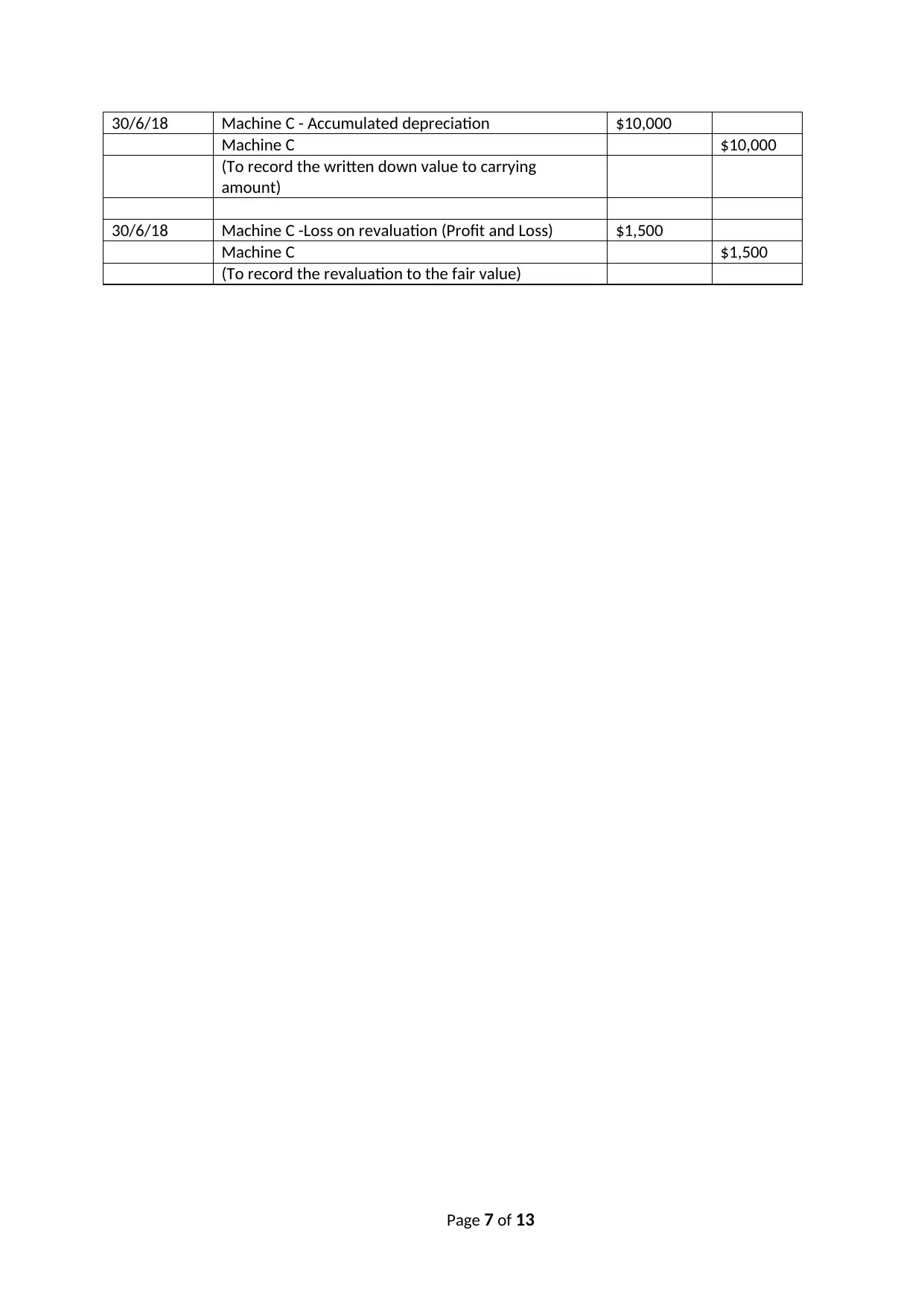
30/6/18 Machine C - Accumulated depreciation $10,000
Machine C $10,000
(To record the written down value to carrying
amount)
30/6/18 Machine C -Loss on revaluation (Profit and Loss) $1,500
Machine C $1,500
(To record the revaluation to the fair value)
Page 7 of 13
Machine C $10,000
(To record the written down value to carrying
amount)
30/6/18 Machine C -Loss on revaluation (Profit and Loss) $1,500
Machine C $1,500
(To record the revaluation to the fair value)
Page 7 of 13
Paraphrase This Document
Need a fresh take? Get an instant paraphrase of this document with our AI Paraphraser

Question 3. Ex 6.11
Accounting Justification:
The internally generated intangibles assets focus on the criteria of the recognition also the
generation of the assets to be classify as the-
1. Development Phase
2. Research Phase
Relevant Issues:
In this problem we focus on the analysis of AASB 138/IAS 38 in terms of internally generated
intangibles assets.
1. Explain accounting issues
The expense on the development of internally generated intangibles may be dependent on whether
the expenditure is classified as R&D. Research always plan for investigation of new knowledge and
development is the important application of the research findings (Warren Ruppel, 2017..pp44).
Research expense consider as the expense as incurred and development expense capitalized if all
the 6 criteria in para 57 of AASB 138 are met (Abbas Ali Mirza, 2015...pp37).
The AASB 138 explains that the internally generated intangibles like mastheads or brands not be
recognize also this list not focused on the patents.
2. Differences Internally Generated vs Acquired
It is very easy to recognize the intangibles when they are acquire in the comparison of when they are
internally generated. For acquiring of the intangibles there is a market of transaction and all
acquired assets measure at cost for the business measure at the fair value for business
combinations.
Page 8 of 13
Accounting Justification:
The internally generated intangibles assets focus on the criteria of the recognition also the
generation of the assets to be classify as the-
1. Development Phase
2. Research Phase
Relevant Issues:
In this problem we focus on the analysis of AASB 138/IAS 38 in terms of internally generated
intangibles assets.
1. Explain accounting issues
The expense on the development of internally generated intangibles may be dependent on whether
the expenditure is classified as R&D. Research always plan for investigation of new knowledge and
development is the important application of the research findings (Warren Ruppel, 2017..pp44).
Research expense consider as the expense as incurred and development expense capitalized if all
the 6 criteria in para 57 of AASB 138 are met (Abbas Ali Mirza, 2015...pp37).
The AASB 138 explains that the internally generated intangibles like mastheads or brands not be
recognize also this list not focused on the patents.
2. Differences Internally Generated vs Acquired
It is very easy to recognize the intangibles when they are acquire in the comparison of when they are
internally generated. For acquiring of the intangibles there is a market of transaction and all
acquired assets measure at cost for the business measure at the fair value for business
combinations.
Page 8 of 13
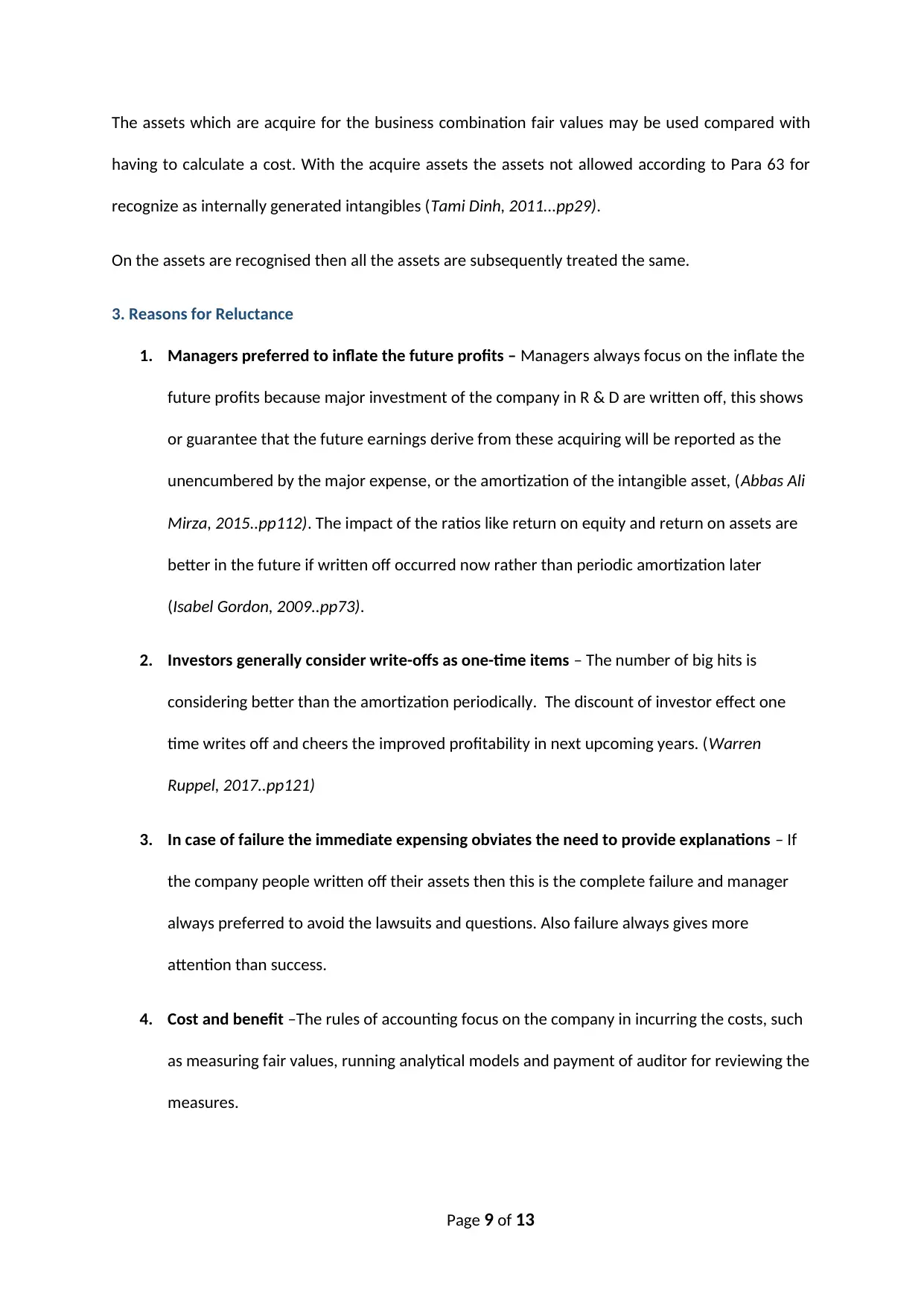
The assets which are acquire for the business combination fair values may be used compared with
having to calculate a cost. With the acquire assets the assets not allowed according to Para 63 for
recognize as internally generated intangibles (Tami Dinh, 2011...pp29).
On the assets are recognised then all the assets are subsequently treated the same.
3. Reasons for Reluctance
1. Managers preferred to inflate the future profits – Managers always focus on the inflate the
future profits because major investment of the company in R & D are written off, this shows
or guarantee that the future earnings derive from these acquiring will be reported as the
unencumbered by the major expense, or the amortization of the intangible asset, (Abbas Ali
Mirza, 2015..pp112). The impact of the ratios like return on equity and return on assets are
better in the future if written off occurred now rather than periodic amortization later
(Isabel Gordon, 2009..pp73).
2. Investors generally consider write-offs as one-time items – The number of big hits is
considering better than the amortization periodically. The discount of investor effect one
time writes off and cheers the improved profitability in next upcoming years. (Warren
Ruppel, 2017..pp121)
3. In case of failure the immediate expensing obviates the need to provide explanations – If
the company people written off their assets then this is the complete failure and manager
always preferred to avoid the lawsuits and questions. Also failure always gives more
attention than success.
4. Cost and benefit –The rules of accounting focus on the company in incurring the costs, such
as measuring fair values, running analytical models and payment of auditor for reviewing the
measures.
Page 9 of 13
having to calculate a cost. With the acquire assets the assets not allowed according to Para 63 for
recognize as internally generated intangibles (Tami Dinh, 2011...pp29).
On the assets are recognised then all the assets are subsequently treated the same.
3. Reasons for Reluctance
1. Managers preferred to inflate the future profits – Managers always focus on the inflate the
future profits because major investment of the company in R & D are written off, this shows
or guarantee that the future earnings derive from these acquiring will be reported as the
unencumbered by the major expense, or the amortization of the intangible asset, (Abbas Ali
Mirza, 2015..pp112). The impact of the ratios like return on equity and return on assets are
better in the future if written off occurred now rather than periodic amortization later
(Isabel Gordon, 2009..pp73).
2. Investors generally consider write-offs as one-time items – The number of big hits is
considering better than the amortization periodically. The discount of investor effect one
time writes off and cheers the improved profitability in next upcoming years. (Warren
Ruppel, 2017..pp121)
3. In case of failure the immediate expensing obviates the need to provide explanations – If
the company people written off their assets then this is the complete failure and manager
always preferred to avoid the lawsuits and questions. Also failure always gives more
attention than success.
4. Cost and benefit –The rules of accounting focus on the company in incurring the costs, such
as measuring fair values, running analytical models and payment of auditor for reviewing the
measures.
Page 9 of 13
⊘ This is a preview!⊘
Do you want full access?
Subscribe today to unlock all pages.

Trusted by 1+ million students worldwide
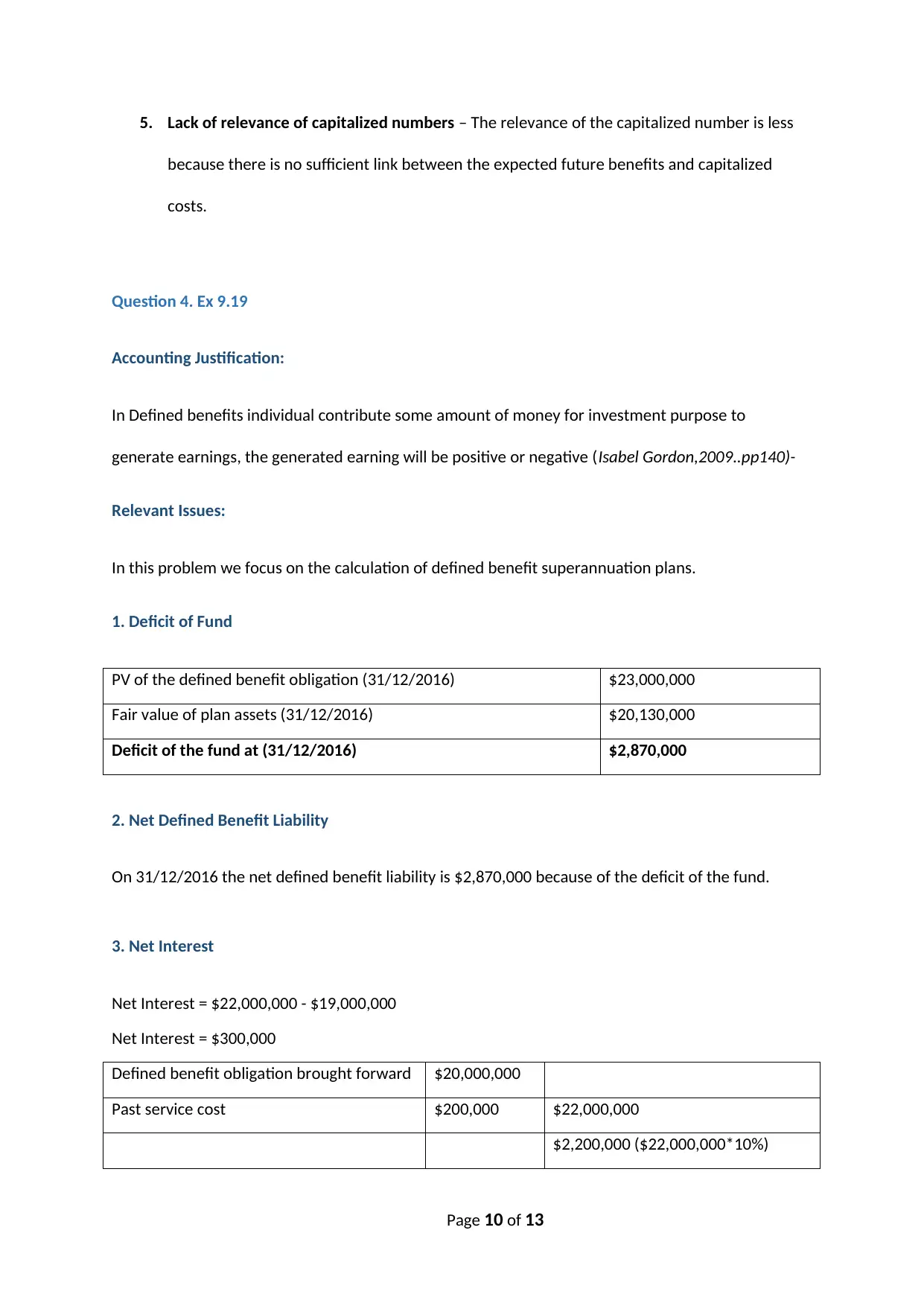
5. Lack of relevance of capitalized numbers – The relevance of the capitalized number is less
because there is no sufficient link between the expected future benefits and capitalized
costs.
Question 4. Ex 9.19
Accounting Justification:
In Defined benefits individual contribute some amount of money for investment purpose to
generate earnings, the generated earning will be positive or negative (Isabel Gordon,2009..pp140)-
Relevant Issues:
In this problem we focus on the calculation of defined benefit superannuation plans.
1. Deficit of Fund
PV of the defined benefit obligation (31/12/2016) $23,000,000
Fair value of plan assets (31/12/2016) $20,130,000
Deficit of the fund at (31/12/2016) $2,870,000
2. Net Defined Benefit Liability
On 31/12/2016 the net defined benefit liability is $2,870,000 because of the deficit of the fund.
3. Net Interest
Net Interest = $22,000,000 - $19,000,000
Net Interest = $300,000
Defined benefit obligation brought forward $20,000,000
Past service cost $200,000 $22,000,000
$2,200,000 ($22,000,000*10%)
Page 10 of 13
because there is no sufficient link between the expected future benefits and capitalized
costs.
Question 4. Ex 9.19
Accounting Justification:
In Defined benefits individual contribute some amount of money for investment purpose to
generate earnings, the generated earning will be positive or negative (Isabel Gordon,2009..pp140)-
Relevant Issues:
In this problem we focus on the calculation of defined benefit superannuation plans.
1. Deficit of Fund
PV of the defined benefit obligation (31/12/2016) $23,000,000
Fair value of plan assets (31/12/2016) $20,130,000
Deficit of the fund at (31/12/2016) $2,870,000
2. Net Defined Benefit Liability
On 31/12/2016 the net defined benefit liability is $2,870,000 because of the deficit of the fund.
3. Net Interest
Net Interest = $22,000,000 - $19,000,000
Net Interest = $300,000
Defined benefit obligation brought forward $20,000,000
Past service cost $200,000 $22,000,000
$2,200,000 ($22,000,000*10%)
Page 10 of 13
Paraphrase This Document
Need a fresh take? Get an instant paraphrase of this document with our AI Paraphraser
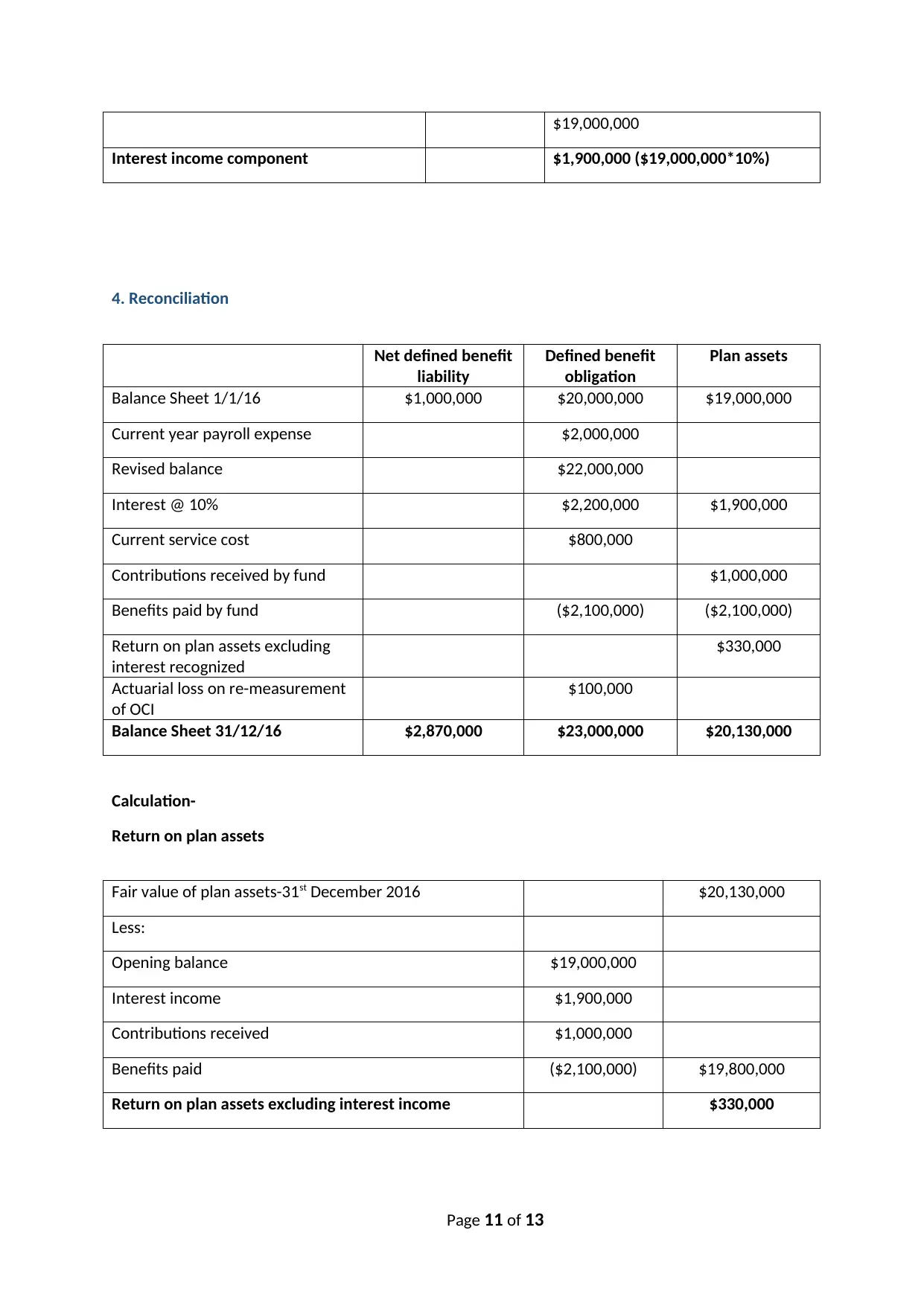
$19,000,000
Interest income component $1,900,000 ($19,000,000*10%)
4. Reconciliation
Net defined benefit
liability
Defined benefit
obligation
Plan assets
Balance Sheet 1/1/16 $1,000,000 $20,000,000 $19,000,000
Current year payroll expense $2,000,000
Revised balance $22,000,000
Interest @ 10% $2,200,000 $1,900,000
Current service cost $800,000
Contributions received by fund $1,000,000
Benefits paid by fund ($2,100,000) ($2,100,000)
Return on plan assets excluding
interest recognized
$330,000
Actuarial loss on re-measurement
of OCI
$100,000
Balance Sheet 31/12/16 $2,870,000 $23,000,000 $20,130,000
Calculation-
Return on plan assets
Fair value of plan assets-31st December 2016 $20,130,000
Less:
Opening balance $19,000,000
Interest income $1,900,000
Contributions received $1,000,000
Benefits paid ($2,100,000) $19,800,000
Return on plan assets excluding interest income $330,000
Page 11 of 13
Interest income component $1,900,000 ($19,000,000*10%)
4. Reconciliation
Net defined benefit
liability
Defined benefit
obligation
Plan assets
Balance Sheet 1/1/16 $1,000,000 $20,000,000 $19,000,000
Current year payroll expense $2,000,000
Revised balance $22,000,000
Interest @ 10% $2,200,000 $1,900,000
Current service cost $800,000
Contributions received by fund $1,000,000
Benefits paid by fund ($2,100,000) ($2,100,000)
Return on plan assets excluding
interest recognized
$330,000
Actuarial loss on re-measurement
of OCI
$100,000
Balance Sheet 31/12/16 $2,870,000 $23,000,000 $20,130,000
Calculation-
Return on plan assets
Fair value of plan assets-31st December 2016 $20,130,000
Less:
Opening balance $19,000,000
Interest income $1,900,000
Contributions received $1,000,000
Benefits paid ($2,100,000) $19,800,000
Return on plan assets excluding interest income $330,000
Page 11 of 13
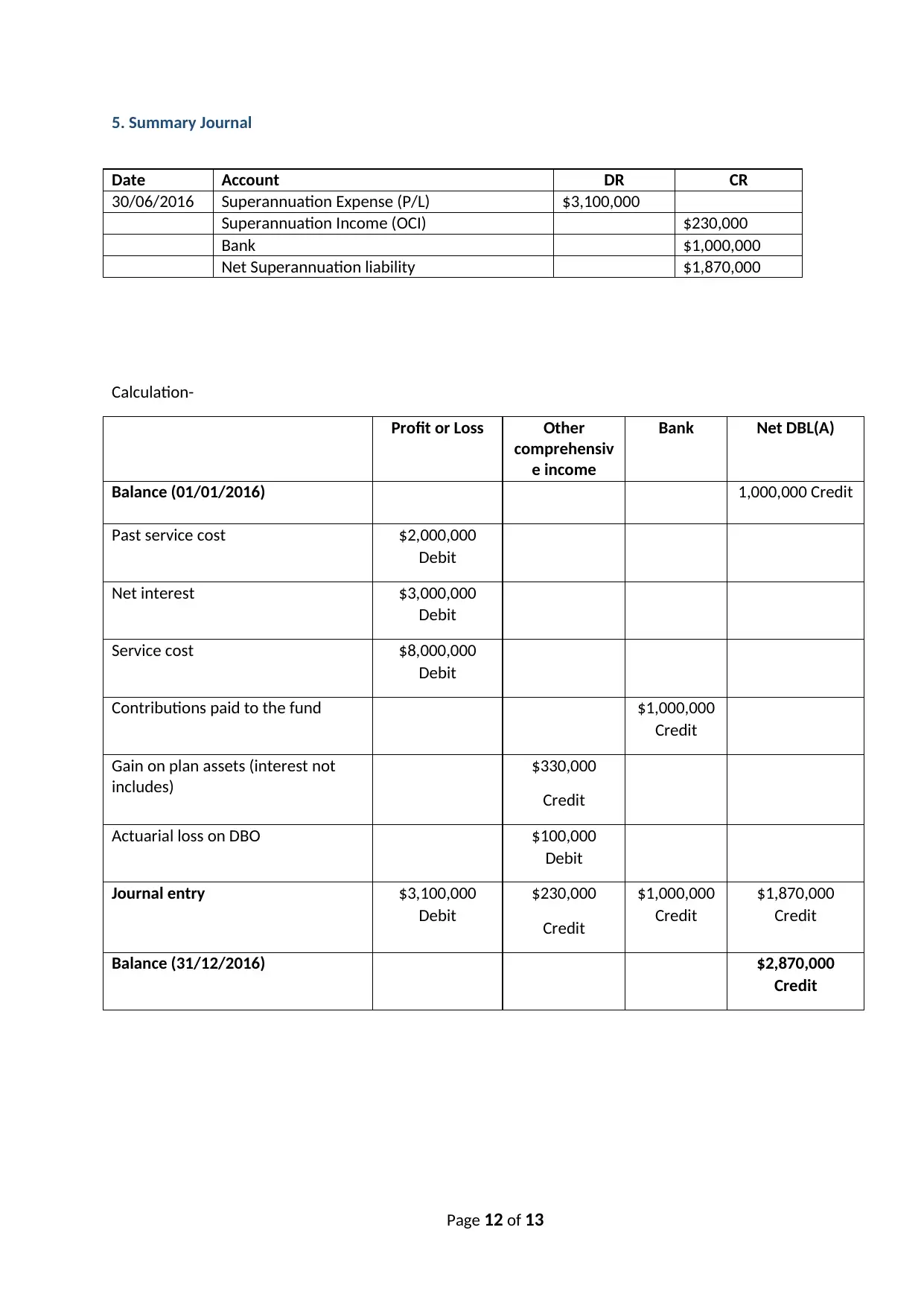
5. Summary Journal
Date Account DR CR
30/06/2016 Superannuation Expense (P/L) $3,100,000
Superannuation Income (OCI) $230,000
Bank $1,000,000
Net Superannuation liability $1,870,000
Calculation-
Profit or Loss Other
comprehensiv
e income
Bank Net DBL(A)
Balance (01/01/2016) 1,000,000 Credit
Past service cost $2,000,000
Debit
Net interest $3,000,000
Debit
Service cost $8,000,000
Debit
Contributions paid to the fund $1,000,000
Credit
Gain on plan assets (interest not
includes)
$330,000
Credit
Actuarial loss on DBO $100,000
Debit
Journal entry $3,100,000
Debit
$230,000
Credit
$1,000,000
Credit
$1,870,000
Credit
Balance (31/12/2016) $2,870,000
Credit
Page 12 of 13
Date Account DR CR
30/06/2016 Superannuation Expense (P/L) $3,100,000
Superannuation Income (OCI) $230,000
Bank $1,000,000
Net Superannuation liability $1,870,000
Calculation-
Profit or Loss Other
comprehensiv
e income
Bank Net DBL(A)
Balance (01/01/2016) 1,000,000 Credit
Past service cost $2,000,000
Debit
Net interest $3,000,000
Debit
Service cost $8,000,000
Debit
Contributions paid to the fund $1,000,000
Credit
Gain on plan assets (interest not
includes)
$330,000
Credit
Actuarial loss on DBO $100,000
Debit
Journal entry $3,100,000
Debit
$230,000
Credit
$1,000,000
Credit
$1,870,000
Credit
Balance (31/12/2016) $2,870,000
Credit
Page 12 of 13
⊘ This is a preview!⊘
Do you want full access?
Subscribe today to unlock all pages.

Trusted by 1+ million students worldwide
1 out of 13
Related Documents
Your All-in-One AI-Powered Toolkit for Academic Success.
+13062052269
info@desklib.com
Available 24*7 on WhatsApp / Email
![[object Object]](/_next/static/media/star-bottom.7253800d.svg)
Unlock your academic potential
Copyright © 2020–2025 A2Z Services. All Rights Reserved. Developed and managed by ZUCOL.





